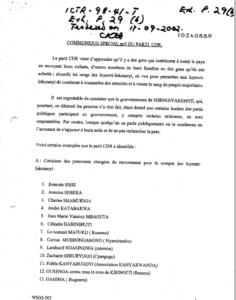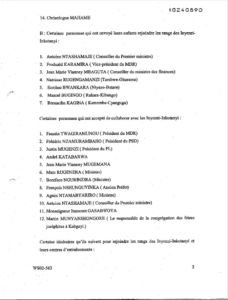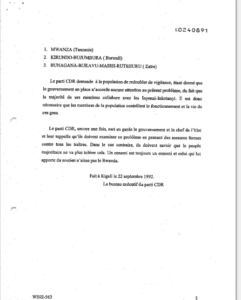All days were traumatic since the 1960s for the Tutsi in Rwanda but September 21, 1992 brought a new painful development in the long plan to wipe out the ethnic group.
This Monday was a day the government published a threat assessment, nearly a year in the making, marking Tutsi within and outside Rwanda as national enemies.
The threat assessment contained conclusions of a 10-member commission that had been working on it since the previous December. It was released by Colonel Déogratias Nsabimana, a relative of President Habyarimana who had been appointed chief of defense staff — the highest job in military command — just five months earlier.
The six-month-old far-right Hutu Power party Coalition for the Defence of the Republic (French: Coalition pour la Défence de la République, CDR) jumped at the plan to orchestrate murder of the Tutsi.
CDR, which started as an opposition party, quickly gained support from the main ruling party. Its slogan was ‘Mube maso’ (“Watch out!”), which meant that Hutus should beware or “the Tutsis would rule them as they had in the past.”
Local rights activists report that the following morning — September 22 — members of CDR launched a program to track and kill Tutsi. Some set out immediately to kill, loot, and burn Tutsi property, while others began to construct a list.
The list, typed at CDR and signed by the executive committee from their Gikondo Nyenyeri office named specific Tutsi the group wanted killed.
“CDR raised their flag next to MRND’s in Nyakabanda sector, Kicukiro district and started hunting the Tutsi along Sonatube – Remera highway. They killed one Emmanuel Bwimana, a retailer for having played a music piece authored by Cecile Kayirebwa, a legendary Rwandan singer who was reputed pro –Inkotanyi,” reads part of a report by local human rights activists.
The Notorious List
The list, titled “Communiqué Spécial No 5 du Parti CDR,” is available among unclassified documents of the International Criminal Tribunal for Rwanda.
It reads, “CDR has reliably established that there are people who continue to betray the country while sending their children or family members to serve Inyenzi — Inkotanyi, allowing them to perpetrate massacres against the Rwandan majority (Hutu).”
The party then named thirty two people whom they accused of recruiting for the Rwanda Patriotic Front (RPF) Inkotanyi, sending their children to serve the rebel group and collaborating with them.
The list names primarily civil society activists, politicians and members of the opposition party, and journalists.
CDR closed the list while saying, “We request the general public to be watchful because the government is indifferent towards this problem. After all, our government is dominated by pro – Inkotanyi members,” reads part of the concluding two paragraphs.
“CDR warns the government and the head of state and asks them to look into the case of these traitors. Failure to do that, rest informed that the majority Rwandans (Hutu) will not tolerate that,” the notice reads. “An enemy is always an enemy and everyone who supports him does not love Rwanda neither.”
Survivors still under shock
When the Genocide began on April 7, 1994, Interahamwe militia and CDR in collaboration with government soldiers started hunting down the people on their list. The first to be killed was Landouard Ndasingwa, ninth on the list of “people recruiting for RPF.” Ndasingwa was then minister of the Liberal Party.
They also killed Frederic Nzamurambaho, a minister from Social Democratic Party (PSD), ranked second on the list of “RPF collaborators.” His wife and three children were also killed.
According to sources close to Nzamurambaho at the time, the politician would never compromise when his conscience was not clear – despite spending almost two decades close to the echelons of power.
Several attempts were made on his life, apparently, by the regime. Once he was almost killed in a staged car crash, said his son, Fernand Nzamurambaho.
“We were told of several attempts to kill him,” Nzamurambaho said. “Sometimes, he was warned that people wanted to poison him.”
“The Genocide started in this house of ours,” said Spéciose Kanyabugoyi, the widow of rights activist Fidèle Kanyabugoyi. Her husband was also on the list and was killed on April 11, 1994.
“Some people experienced the Genocide in 1994, but for us, we were targeted since 1973.”

The story of Fidele Kanyabugoyi remains a painful chapter in Rwandan history
Spéciose Kanyabugoyi is now in her 70s and lives in Kicukiro. Her husband was No. 11 on the CDR’s list. He was an engineer who had worked since the late 1960s in the department of water management for the Ministry of Public Infrastructure.
In 1991, he co-founded Kanyarwanda, a civil society organization aimed at defending human rights. He was the first chairperson of the organization. Under Kanyarwanda, he also founded and wrote for the newspaper Kanyarwanda.
Fideli, as his widow likes to call Kanyabugoyi, made several statements against the government-perpetrated killings, including a statement against the September 22 violence.
Before they killed him, Interahamwe militia mockingly said it would be unfortunate for the paper.
“Interahamwe told my husband, ‘what will Kanyarwanda newspaper become? Your esteemed readers are going to miss you, sad!’” Kanyabugoyi’s wife said, remembering April 11, 1994.
The Kanyabugoyi’s family – including parents and five children fled to the Ecole Technique Officielle (ETO) in Kicukiro when the Genocide came to their neighborhood on April 11, she said.
“We expected protection from the UN mission in Rwanda, but they left us in the hands of Interahamwe the same evening,” she said.
Interahamwe paraded thousands of Tutsi down the Sonatube road and then up the hill in Nyanza, killing them along the highway to Bugesera.
“We were laid down on Nyanza hill when a militia slaughtered my husband with a machete,” she said. “I survived only because the militia confused me with the dead.”
RPF Inkotanyi found and rescued her the following day.
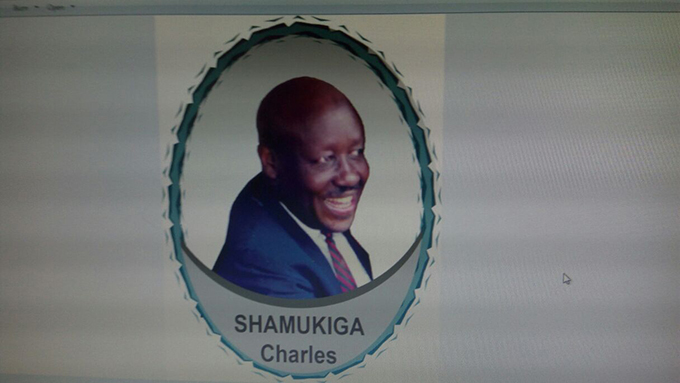
Late Charles Shamukiga founder of APACOPE
Deserved to die or live much longer?
Fidèle Kanyabugoyi had been mentally unstable since the 1970s, when his supervisors began targeting him and fellow Tutsi at work, Mrs. Kanyabugoyi said. Issues of lists were not new in their life.
“Another event I will never forget is a list my husband found on the door one morning of 1973. He reported to work to find he was number one on a list of employees who were sacked without any explanation,” she said.
He was called back to work four months later when the ministry realized there was no one competent enough to replace him.
However, they kept harassing him. They chased him from the government home he was given as a civil servant. In 1978, Fidèle Kanyabugoyi relocated his family in a home he was building in Niboye sector, Kicukiro district.
More troubles happened in 1991 during the massacre of Bagogwe in current Nyabihu district. Forty of Fidèle’s relatives fled to his house for safety, and the government accused him of hosting Inyenzi, Mrs. Kanyabugoyi said. Government soldiers came to arrest him.
The CDR list included people who had a vision on what Rwanda is achieving today.
Despite being a construction entrepreneur, late Charles Shamukiga had a vision of education for all. In 1981, he founded the Association des Parents pour l’Education (APACOPE) in Nyarugenge district.
“His aim was to give right to education all children that were being segregated and refused right to education,” said Christine Shamukiga, the daughter to Charles Shamukiga and current chairperson of APACOPE.
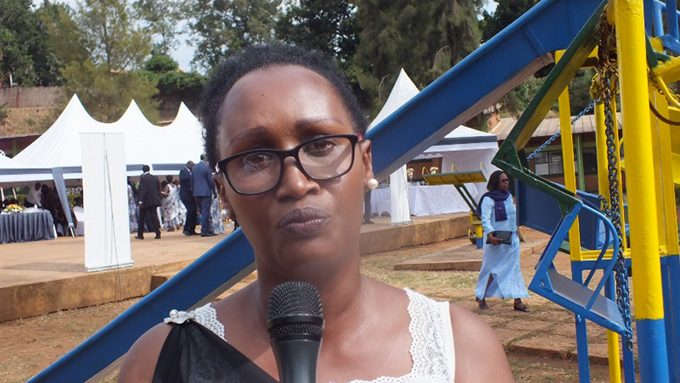
Christine Shamukiga the daughter to Charles Shamukiga. She survived the Genocide
Christine Shamukiga said her father “loved to see all children at school, but the ruling power took him as an accomplice, a traitor saying he had turned the school into a recruitment center for RPF.”
Currently, APACOPE has about 1500 students that benefit quality education from nursery to Ordinary level.
CDR list was made and many more lists, bigger than this were also made. However, says Christine Shamukiga, in the end every Tutsi either on a list or not was killed.

